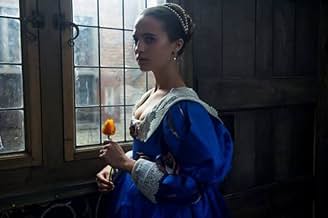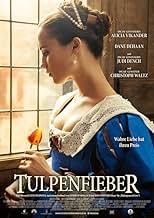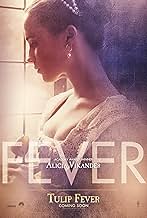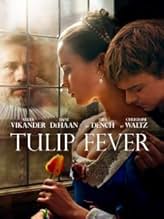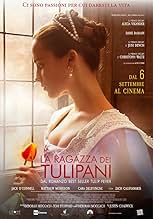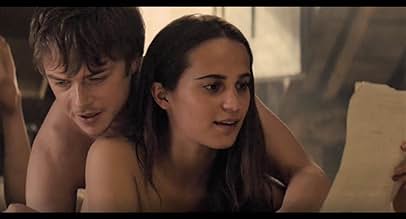IMDb-BEWERTUNG
6,2/10
23.953
IHRE BEWERTUNG
Ein Künstler verliebt sich in eine junge verheiratete Frau, als er während des Tulpenfiebers im Amsterdam des 17. Jahrhunderts den Auftrag erhält, ein Porträt von ihr zu malen.Ein Künstler verliebt sich in eine junge verheiratete Frau, als er während des Tulpenfiebers im Amsterdam des 17. Jahrhunderts den Auftrag erhält, ein Porträt von ihr zu malen.Ein Künstler verliebt sich in eine junge verheiratete Frau, als er während des Tulpenfiebers im Amsterdam des 17. Jahrhunderts den Auftrag erhält, ein Porträt von ihr zu malen.
- Auszeichnungen
- 1 Nominierung insgesamt
Richard Alan Reid
- Bidder 1
- (as Richard Reid)
Empfohlene Bewertungen
A pretty good period piece set in an interesting location during an even more interesting time, could have been great, but overall it's still good enough.. Christoph Waltz walks on water as always!
Here is only one review of the 2014-version. Based on that review, it is fair to say that some of the plot holes have obviously been stuffed, while others are still wide open (or have been opened). I don't know if the holes have been faithfully adapted from the book or if they were specifically designed for the film.
In the 16th century there was a big economic bubble based on tulip onions. This is the background for a romance between a painter and a married woman. They make out a plan to get rich fast, so that they can run away to the East Indies. So far, so good. The point is now that the two strings never really are woven properly together. The development of the plot is, at best, sketchy. Character development, if any, is rather rhapsodical. The lovers (Vikander and DeHaan) are not really likable. The script gives them zero personality and they compensate by overacting. The only person carrying a bit of sympathy is the cheated husband (Waltz). On the other hand the makers strive to give us impressions of street life then, raw, loud and rather vulgar it is in their view. The final twist of the plot is surprising, but not convincing.
There are further things that were rather annoying in this film: The use of a narrator. It seemed that the makers didn't trust the force of their pictures and thought they had to spell it out for more distracted viewers. Shaky camera and fast clipping. I think it is a misconception to edit a costume drama to fit the taste of the MTV generation. (Make it more like The Girl with a Pearl Earring!)
One reason for historical fiction is to make us understand the burst of the recent economic bubble on the basis of a historical example. The makers of this film didn't really succeed in doing that. The persons in this film are far away and two-dimensional like drawings on a wall. Unless you write a review about them, you have already forgotten them tomorrow.
In the 16th century there was a big economic bubble based on tulip onions. This is the background for a romance between a painter and a married woman. They make out a plan to get rich fast, so that they can run away to the East Indies. So far, so good. The point is now that the two strings never really are woven properly together. The development of the plot is, at best, sketchy. Character development, if any, is rather rhapsodical. The lovers (Vikander and DeHaan) are not really likable. The script gives them zero personality and they compensate by overacting. The only person carrying a bit of sympathy is the cheated husband (Waltz). On the other hand the makers strive to give us impressions of street life then, raw, loud and rather vulgar it is in their view. The final twist of the plot is surprising, but not convincing.
There are further things that were rather annoying in this film: The use of a narrator. It seemed that the makers didn't trust the force of their pictures and thought they had to spell it out for more distracted viewers. Shaky camera and fast clipping. I think it is a misconception to edit a costume drama to fit the taste of the MTV generation. (Make it more like The Girl with a Pearl Earring!)
One reason for historical fiction is to make us understand the burst of the recent economic bubble on the basis of a historical example. The makers of this film didn't really succeed in doing that. The persons in this film are far away and two-dimensional like drawings on a wall. Unless you write a review about them, you have already forgotten them tomorrow.
How could such a beautiful looking movie fall so flat? Sumptuous filming, a stellar cast, with brilliant period sets and costumes are not enough to disguise the fact that Tulip Fever (2017) drowns under the weight of its own plot contrivance and melodramatic performances.
Set in 17th Century Amsterdam, it tells the story of an orphan who "arrived barefoot and left in a carriage". Selected to marry for her great beauty, Sophia's (Alicia Vikander) sole purpose is to bear a child for wealthy merchant Cornelius (Christopher Waltz) whose first marriage was barren. Cornelius commissions struggling artist Jan (Dane DeHaan) to paint their portrait to celebrate his wealth and her beauty but the artist immediately falls under her spell. While the affair progresses, her maidservant Maria (Holliday Grainger) falls pregnant to a fishmonger and the two women concoct a subterfuge whereby Sophia pretends to be pregnant to keep Maria's secret. As a background sub-plot, Jan seeks his fortune in the over-heated tulip market by purchasing the rarest of tulip specimens from an imperious nun (Judi Dench). Melodrama turns into farce as the multiple narratives interweave, tighten, yet ultimately go nowhere.
High visual production values do not make up for story implausibility. The months of unsuccessful mating between Cornelius and Sophia is portrayed as a bawdy comedy of nightly rituals where Cornelius struggles to perform his marital duties. The affair under her husband's nose, the fake pregnancy, and fake birth are all ludicrously implausible. The background tale of wild speculations on the fickle tulip market is a distraction rather than necessary for Jan's predictable investment outcomes. The script sounds unnatural and dialogue is delivered unconvincingly: many lines are spoken across class boundaries in ways that would have been unimaginable in that era. With a top- shelf cast, the acting is flawless although Alicia Vikander stands out for the way she plays the same Alicia Vikander that we have seen in several films. The chemistry with both husband and lover is of the barely flickering variety, and her impersonation of Mona Lisa is, as always, impeccable.
Does the film's ending justify the effort? Disappointingly, no. The fate of all the characters is disconnected from the narrative flow and the storyline threads remain dangling in the wind. For some audiences, the beauty of this production will be worth the commitment. However, after an hour and forty-five minutes, all we learn is that great beauty, wealth, greed, and deception, do not bring happiness; nor do aesthetics alone make a great movie.
Set in 17th Century Amsterdam, it tells the story of an orphan who "arrived barefoot and left in a carriage". Selected to marry for her great beauty, Sophia's (Alicia Vikander) sole purpose is to bear a child for wealthy merchant Cornelius (Christopher Waltz) whose first marriage was barren. Cornelius commissions struggling artist Jan (Dane DeHaan) to paint their portrait to celebrate his wealth and her beauty but the artist immediately falls under her spell. While the affair progresses, her maidservant Maria (Holliday Grainger) falls pregnant to a fishmonger and the two women concoct a subterfuge whereby Sophia pretends to be pregnant to keep Maria's secret. As a background sub-plot, Jan seeks his fortune in the over-heated tulip market by purchasing the rarest of tulip specimens from an imperious nun (Judi Dench). Melodrama turns into farce as the multiple narratives interweave, tighten, yet ultimately go nowhere.
High visual production values do not make up for story implausibility. The months of unsuccessful mating between Cornelius and Sophia is portrayed as a bawdy comedy of nightly rituals where Cornelius struggles to perform his marital duties. The affair under her husband's nose, the fake pregnancy, and fake birth are all ludicrously implausible. The background tale of wild speculations on the fickle tulip market is a distraction rather than necessary for Jan's predictable investment outcomes. The script sounds unnatural and dialogue is delivered unconvincingly: many lines are spoken across class boundaries in ways that would have been unimaginable in that era. With a top- shelf cast, the acting is flawless although Alicia Vikander stands out for the way she plays the same Alicia Vikander that we have seen in several films. The chemistry with both husband and lover is of the barely flickering variety, and her impersonation of Mona Lisa is, as always, impeccable.
Does the film's ending justify the effort? Disappointingly, no. The fate of all the characters is disconnected from the narrative flow and the storyline threads remain dangling in the wind. For some audiences, the beauty of this production will be worth the commitment. However, after an hour and forty-five minutes, all we learn is that great beauty, wealth, greed, and deception, do not bring happiness; nor do aesthetics alone make a great movie.
Tulipmania is one of Europe's weirder historical events. Unfortunately, the movie barely touches on the tulip market craze, except as a deus ex machina to bestow sudden wealth and/or loss on characters who we barely care about and who do nothing to deserve it.
The main problem with the film is that the love triangle that is supposed to be the main story appears out of nowhere -- one of the characters simply looks up pensively, as if he just solved a riddle, and declares, "I'm in love!" Up until that point, he had shared maybe 60 seconds of screen time with the object of his affection. How can we care about the contrived swings in fortune of such shallow people?
Making things worse, this love triangle movie has five main characters, leading to underdeveloped characters, repetition of ideas and unnecessary subplots.
I loved the sets and I thought that Christoph Waltz, Holliday Grainger and Jack O'Connell did great jobs with the little they had to work with.
The main problem with the film is that the love triangle that is supposed to be the main story appears out of nowhere -- one of the characters simply looks up pensively, as if he just solved a riddle, and declares, "I'm in love!" Up until that point, he had shared maybe 60 seconds of screen time with the object of his affection. How can we care about the contrived swings in fortune of such shallow people?
Making things worse, this love triangle movie has five main characters, leading to underdeveloped characters, repetition of ideas and unnecessary subplots.
I loved the sets and I thought that Christoph Waltz, Holliday Grainger and Jack O'Connell did great jobs with the little they had to work with.
Great cast! Fine Acting! Glossy cinematography! Terrific sets! Excellent costuming! Even an intriguing first half of the film! Yet, ultimately Justin Chadwick's historical romantic drama concerning a 17th-century painter in Amsterdam who falls in love with a married woman whose portrait he has been commissioned to paint, during the period known as "Tulip Mania", fails due to its implausible, improbable, narrative outcomes.
It just goes to show that films left on the studio shelves for 3 years after being completed, before being released, as was the case with Tulip Fever, are usually top - shelved for good reason. In this case the film seems to have suffered through a combination of script and editing deficiencies and some poor directorial choices. It results in a movie that doesn't seem to know whether it wants to be some sort of comedy - drama, or straight out melodrama in corsets.
Whether due to editing or some other production choice, nothing much is ever made really clear. The titular, historically authentic,Tulip Fever itself is barely sketched out and then only against the incessant noise and rowdy crowds of Amsterdam's flower markets. Early in the film a quite close and friendly relationship is hinted at between the 2 female leads, Sophia (Alicia Vikander), a wealthy merchant's unhappy young wife and her maidservant, the more earthy and world - wise Maria (Holiday Grainger). Their love - lives are compared and contrasted with Sophia clearly ensnared in a loveless arranged marriage. But this thread is never really consolidated.
Instead we are served up a mish - mash of multiple storylines concerning fake and real pregnancies, suspicious lovers and various characters seeking their fortunes through investment in an over - heated tulip market. It all ends up being ludicrously implausible and both unfunny and undramatic, with a tacked on, unconvincing conclusion. What a waste!
I've given it a 6, because I'm sure there will be some, who like me, appreciate historical films such as this, with obviously high production values. There's no getting around the fact that Tulip Fever looks good. And Alicia Vikander is perfect as Sophia, plucked from obscurity in an orphanage and selected to marry for her great beauty. Similarly, Grainger succeeds as the pragmatic, Maria, who is anything but a dullard, or your conventional notion of a put upon servant. But these positives can't disguise that Tulip Fever ends up looking and sounding like a completely miscalculated opportunity, rather than a significantly interesting, period drama.
It just goes to show that films left on the studio shelves for 3 years after being completed, before being released, as was the case with Tulip Fever, are usually top - shelved for good reason. In this case the film seems to have suffered through a combination of script and editing deficiencies and some poor directorial choices. It results in a movie that doesn't seem to know whether it wants to be some sort of comedy - drama, or straight out melodrama in corsets.
Whether due to editing or some other production choice, nothing much is ever made really clear. The titular, historically authentic,Tulip Fever itself is barely sketched out and then only against the incessant noise and rowdy crowds of Amsterdam's flower markets. Early in the film a quite close and friendly relationship is hinted at between the 2 female leads, Sophia (Alicia Vikander), a wealthy merchant's unhappy young wife and her maidservant, the more earthy and world - wise Maria (Holiday Grainger). Their love - lives are compared and contrasted with Sophia clearly ensnared in a loveless arranged marriage. But this thread is never really consolidated.
Instead we are served up a mish - mash of multiple storylines concerning fake and real pregnancies, suspicious lovers and various characters seeking their fortunes through investment in an over - heated tulip market. It all ends up being ludicrously implausible and both unfunny and undramatic, with a tacked on, unconvincing conclusion. What a waste!
I've given it a 6, because I'm sure there will be some, who like me, appreciate historical films such as this, with obviously high production values. There's no getting around the fact that Tulip Fever looks good. And Alicia Vikander is perfect as Sophia, plucked from obscurity in an orphanage and selected to marry for her great beauty. Similarly, Grainger succeeds as the pragmatic, Maria, who is anything but a dullard, or your conventional notion of a put upon servant. But these positives can't disguise that Tulip Fever ends up looking and sounding like a completely miscalculated opportunity, rather than a significantly interesting, period drama.
Wusstest du schon
- WissenswertesThis movie was shot in 2014 but the release was postponed for three years. The first test screening happened in November 2014 and didn't get positive reactions. This movie was originally scheduled to be released in June 2016, but the release date was pushed to July 2016, then to February 2017, August 25, 2017, and it was finally released in theaters in September 1, 2017.
- PatzerWhen Jan is telling the bailiffs "if I was liquid now I'd be a bigger fool than I look," his mouth stops moving well before the dubbed line finishes.
- Zitate
Cornelis Sandvoort: First to flower, first to fall.
- VerbindungenReferenced in Midnight Screenings: Valley of Bones (2017)
Top-Auswahl
Melde dich zum Bewerten an und greife auf die Watchlist für personalisierte Empfehlungen zu.
- How long is Tulip Fever?Powered by Alexa
Details
- Erscheinungsdatum
- Herkunftsländer
- Offizielle Standorte
- Sprache
- Auch bekannt als
- Tulip Fever
- Drehorte
- Produktionsfirmen
- Weitere beteiligte Unternehmen bei IMDbPro anzeigen
Box Office
- Budget
- 25.000.000 $ (geschätzt)
- Bruttoertrag in den USA und Kanada
- 2.455.635 $
- Eröffnungswochenende in den USA und in Kanada
- 1.158.017 $
- 3. Sept. 2017
- Weltweiter Bruttoertrag
- 9.204.549 $
- Laufzeit1 Stunde 45 Minuten
- Farbe
- Sound-Mix
- Seitenverhältnis
- 2.35 : 1
Zu dieser Seite beitragen
Bearbeitung vorschlagen oder fehlenden Inhalt hinzufügen







